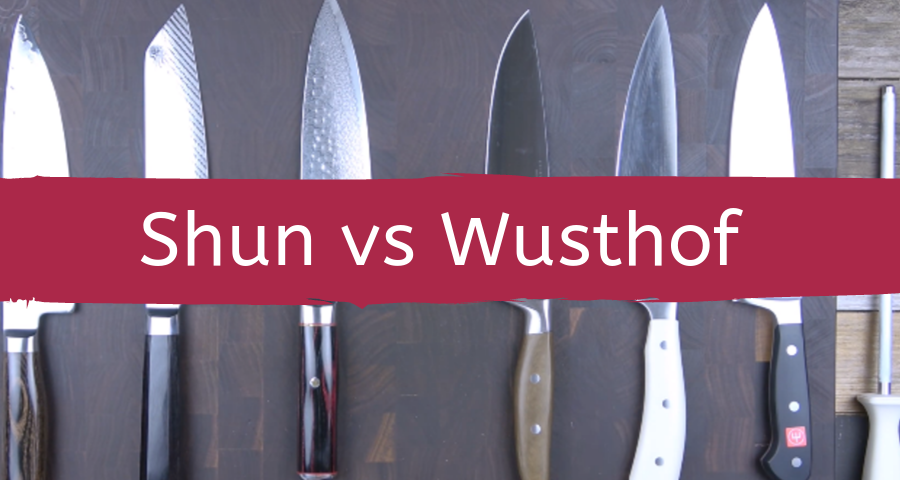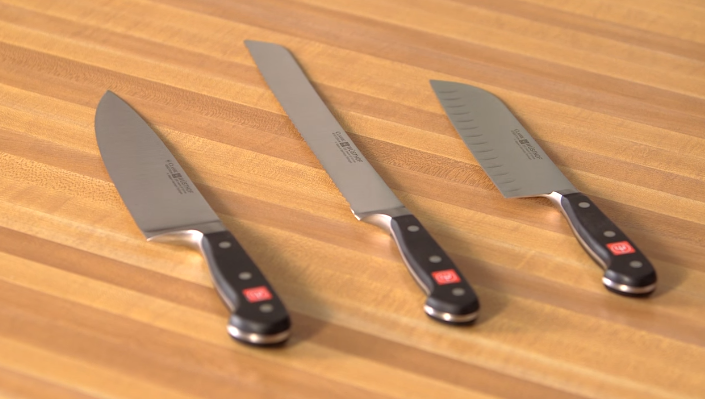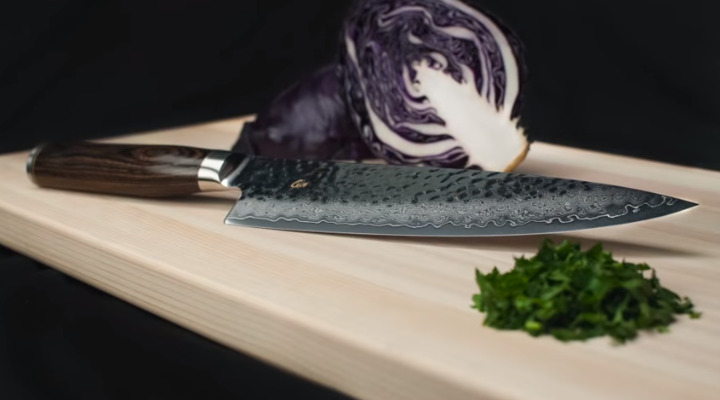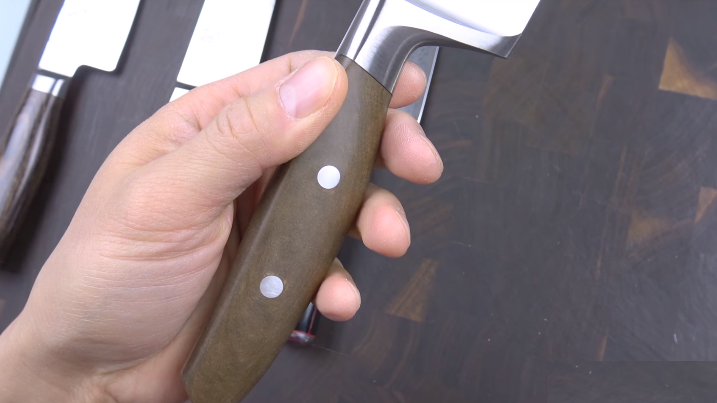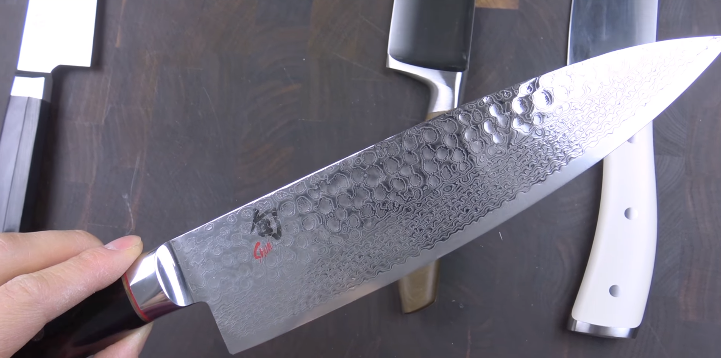While it may seem of little importance at first, having the right knives can make a huge difference in your culinary pursuits. If you’ve never used good knives before then you may not understand, but once you’ve cooked with a quality knife, you’ll never want to go back.
Unfortunately, there are a huge number of considerations to be made, and since good kitchen knives are no small expense, you’ll obviously want to make sure you pick the right brand. That’s why in this article, we’ll be comparing two top knife brands in our Shun vs Wusthof showdown!
We’ll start off with a comparison table to show you how these knives differ, and then give you our top pick. However, if you’re new to knife shopping, then keep reading for our buyer’s guide to learn what you need to know to become an informed consumer.
Shun vs Wusthof – Comparison Chart

| Shun 8″ Chef Knife | Wusthof 8″ Chef Knife | |
| Blade | Full Tang | Full Tang |
| Handle | PakkaWood | Standard |
| Performance | Holds edge better | Higher durability |
| Appearance | Damascus | Standard |
| Bolster | NO | YES |
| Construction | San Mai | Mono-Steel |
| Check Price On Shun | Check Price On Wusthof |
If you don’t know what any of this means, don’t worry! Keep reading for our top pick and a full description of these features.
– Editor
Editor’s Choice: Shun Knives
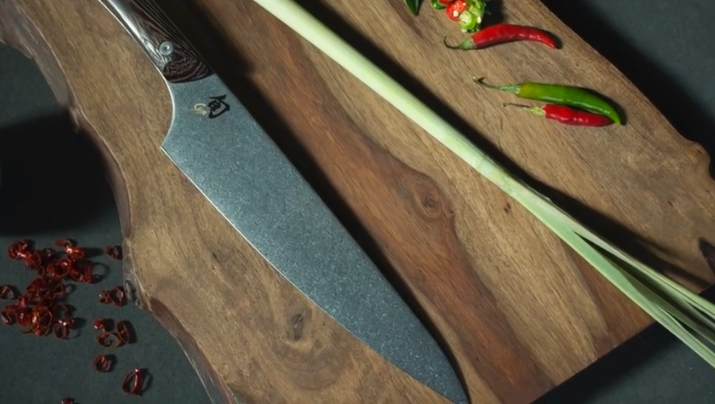
When it comes to the shun vs wusthof debate, Shun gets our money. Though this is mostly a matter of opinion. The truth is, both of these knives will perform perfectly well in the kitchen, but the Shun knives offer more premium features, and they just look better doing it.
Shun uses higher quality San Mai construction, while the Wusthof knives use mono-steel. The Shun knives, hold their edge longer, and they’re also much more attractive than Wusthof knives. However, there is a trade-off here, because Shun knives are also more brittle.
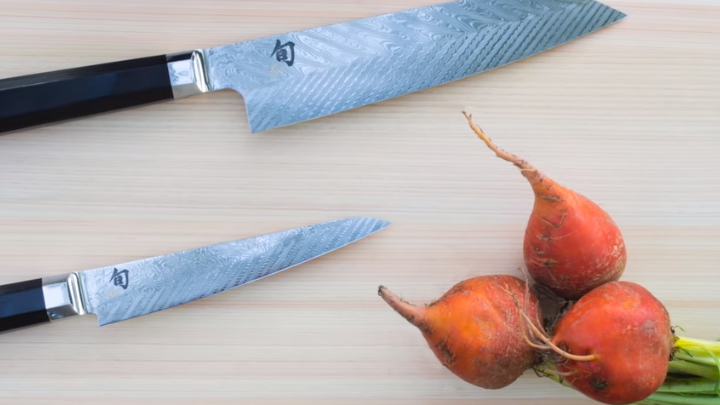
So, if you’re the kind of person that abuses your knives, then you may want to go with the Wusthof. Does this mean that the Shun is badly made? No. It’s a serious piece of kitchen equipment, but you’ll need to be more careful with it and work a little harder to maintain it.
For the purpose of this comparison, we’ve used this Shun 8″ Chef Knife and this Wusthof 8″ Chef Knife. If you’d like to read additional reviews and compare them yourself, then you can do so at the links above.
Okay. That’s the most important bit out of the way, but if you need to know more before you buy, then keep reading for our full write up. While this summary gives the basics for our decision, we go much more in-depth if you’d like to know more about how these knives differ
If not, you then you can generally get the best prices for these knives online. We’d recommend heading over to Amazon to compare the specs and prices for both brands yourself.
Or, keep reading for the full story on both of these knife brands, including a guide for first-time knife buyers and a little insight into the differences between Japanese and German knives to help you out!
Shun Knives – What you need to know
Shun Knives, made in Japan, are a great middle of the road piece of cutlery. They offer excellent performance, but you won’t have to break the bank to acquire one. In our comparison, we used this Shun Chef’s knife. So, we’ll use that one again for this part of the review.
These knives are made using the San Mai construction technique. This means that rather than being made of one piece of metal, the knife is welded from three layers. Using this technique, knives maintain a superior edge and are resistant to corrosion.
While there is no real difference in performance, many people will tell you that there is a difference in “feel”. A San Mai blade may be noticeably stiffer, but whether this is good or bad depends on who you ask, and you likely won’t know your preference until you compare them side-by-side.
However, in the case of the Shun blade we’ve reviewed, you may also find that the material, while offering superior sharpness, is more delicate. Japanese knives have more carbon in them, which is part of the reason why they can maintain their trademark sharpness.
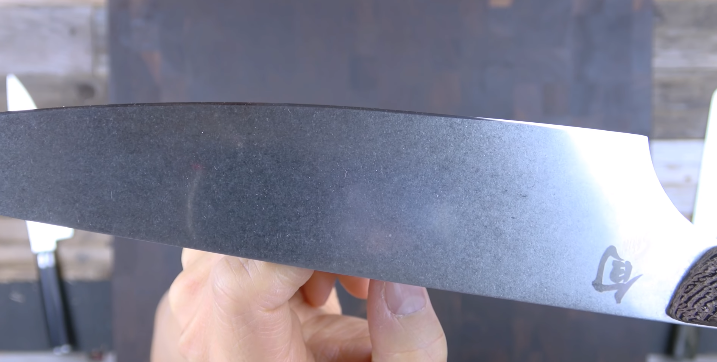
However, the construction required for this also makes the material more brittle. That means that you’ll likely need to treat your Shun knives a little nicer if you want to go with this brand.
These knives are beautiful though, and if your main concern is quality and sharpness, then this is the brand that you’ll want to go with. It’s our personal favorite out of the two. While there is a slight premium in price, we feel that it’s worth it. Especially since knives are not something you buy everyday.
PROS
- Retains sharpness better
- High-quality PakkaWood handles
- Full Tang
- Attractive damascus finish
CONS
- Slightly more brittle
- A bit more expensive
Wusthof Knives – What you need to know
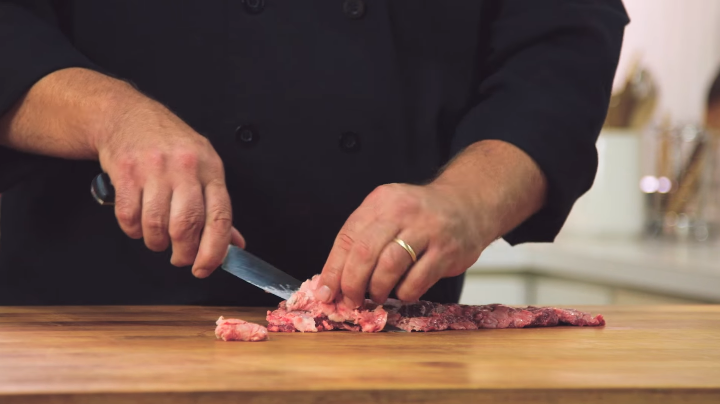
When it comes to Wusthof, they can appear a bit bland when compared to the Shun knives. However, what this knife lacks in looks, it makes up for in durability. If you’re looking for a knife that you can work to death, then this is likely a great choice.
While it’s true that it won’t hold an edge as well as the Shun knives, you’ll be able to abuse it without a second thought. These knives are also a bit cheaper, which lessens the blow of making an amateur mistake that damages a knife.
So, if you’re the type of person that just wants a decent knife that will perform without worry and you don’t care about any fancy finishes or construction techniques, then this one may be for you. These knives do their job and are priced attractively.
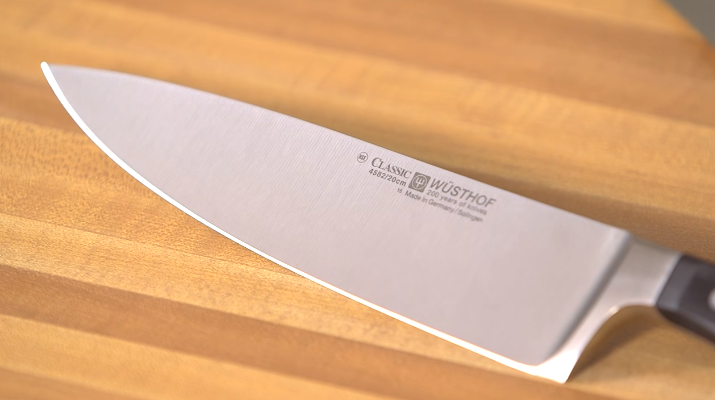
As far as construction goes, Wusthof knives use the mono-steel construction method as opposed to the San Mai method used by Shun. This means that the knife is a single piece of steel, and while performance is similar, the feel of the knife is very different.
Which one is better is highly debatable, but many people enjoy a knife that flexes less and is more durable, and if that’s the case for you, then pick up a Wusthof blade. While not as fancy as Shun, they’re more than up to the tasks that the amateur chef will throw at them.
PROS
- Durable
- Affordable
- Full Tang
CONS
- Loses edge quicker
- Not as attractive
Should I get a knife set or buy single knives?
While many people opt to pick up a knife set, you may be better served to purchase knives individually! Truth be told, you likely won’t be using every knife in the set, so it may be better for you to purchase higher quality versions of what you really need and skip what you don’t.
If you’re new to the whole kitchen knives thing, then purchasing a set can take the anxiety out of your purchase. However, if you’re buying a set primarily because you don’t know what kinds of knives you need, then fear not! In our next section we’ll tell you exactly what you need to buy.
The most important knives for your kitchen
Need a little help choosing? Here are six essential kitchen knives to get you started!
1. Chef’s Knife
Likely the most essential knife in your arsenal. The versatile chef’s knife slices, dices, and even disjoints larger meat cuts. If you buy only one great quality knife, make it this one. You’ll thank yourself for doing so.

| Our Pick For Shun | Our Pick For Wusthof |
| Shun Classic 8″ Chef’s Knife | Wusthof Classic 8″ Chef’s Knife |
2. Paring Knife
Another multi-purpose knife, the paring knife is useful for smaller, detail oriented tasks where large knives just won’t cut it. Think things like peeling potatoes or cutting tomatoes julienne style.
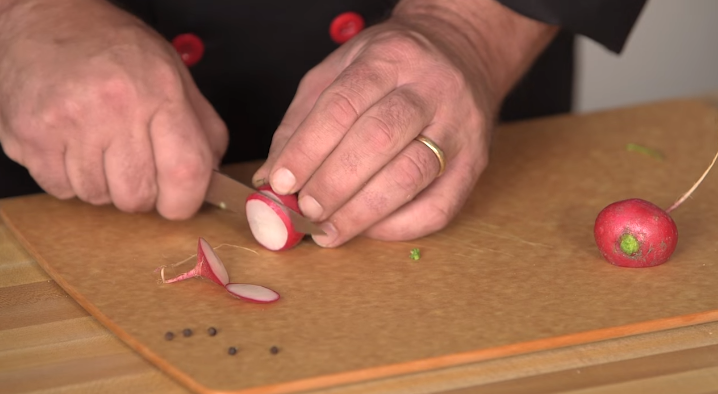
| Our Pick For Shun | Our Pick For Wusthof |
| Shun Classic 4″ Paring Knife | Wusthof Classic 3 1/2″ Paring Knife |
3. Boning Knife
A flexible knife that’s used to remove bones and skin from meat cuts. Make sure to pick one of these up if you’re interested in at-home butchering techniques, because it’s an essential tool.
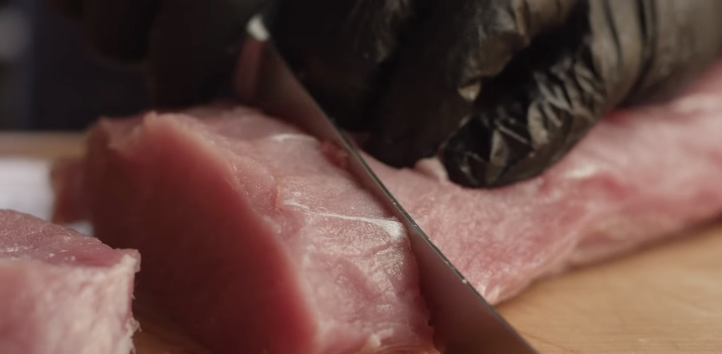
| Our Pick For Shun | Our Pick For Wusthof |
| Shun Classic 6″ Boning Knife | Wusthof 6″ Boning Knife |
4. Carving Knife
A long, narrow blade used mainly for carving meats and poultry. The blade is longer and thinner than the other knives in our list, making it ideal for large roasts, hams, etc.
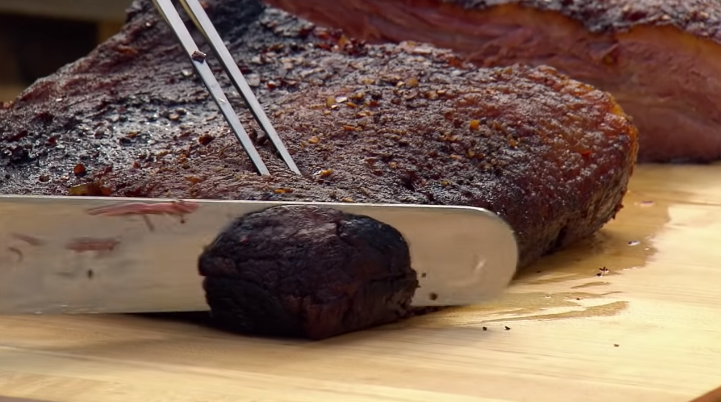
| Our Pick For Shun | Our Pick For Wusthof |
| Shun Classic 8″ Carving Knife | Wusthof Classic Carving Knife |
5. Serrated Knife
Commonly known as a bread knife but also useful for melons, tomatoes and cakes as well. The serrated blade helps you to quickly saw through difficult foods when other knives struggle.
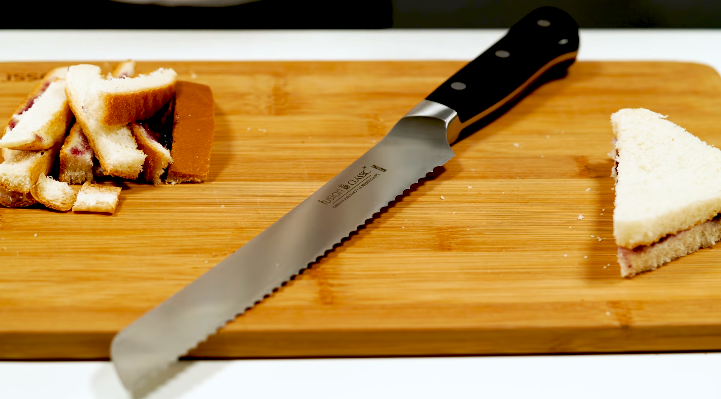
| Our Pick For Shun | Our Pick For Wusthof |
| Shun Premier 9″ Bread Knife | Wusthof Classic Bread Knife |
6. Santoku Knife
While similar to a chef’s knife, the Santoku offers a thinner blade for precision slicing. The Santoku knife also lacks a tip, as found on a Chef’s knife. So, instead of the rocking motion that is commonly associated with the chef’s knife, the Santoku can actually work much faster in downward strokes.
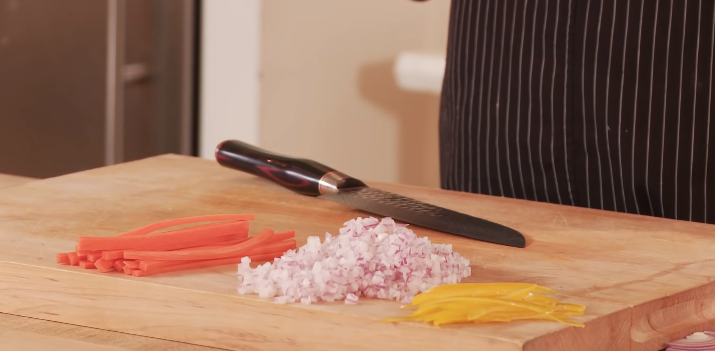
| Our Pick For Shun | Our Pick For Wusthof |
| Shun Premier Santoku Knife | Wustof Classic 7″ Santoku Knife |
If you can’t afford to purchase all of the knives pictured right away, don’t worry! Purchasing single knives makes it affordable to purchase quality knives without emptying your checking account.
For those who are on a budget, my top picks in order of importance would be the Chef’s Knife, Boning Knife, and then the Paring knife if you have to pick what to buy first. You can slowly add more knives to your collection as you can afford them.
While every knife has its place, even just picking up those three knives can allow you to perform a large number of kitchen tasks and work on your knife skills. Most of your kitchen tasks will likely be performed with those knives.
So, which knife brand is better?
The truth is, neither is really “better”. They’re really just different, and aside from the structural differences that we talked about above, there are also design differences which are more.. cultural.
Shun is a Japanese knife brand and as such, they are manufactured to work well with Japanese cooking techniques. This often calls for slicing things very thin, and Sai Mai blades are made to be thinner than mono-steel blades for this reason.
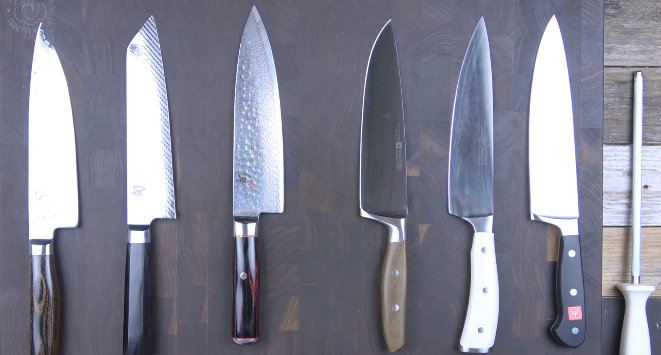
A Japanese blade is generally thinner than a German knife, which allows for a sharper edge. However, as previously stated, this also makes them more prone to chipping, which can quickly become a negative feature if you’re not careful with your knives.
Japanese blades are also almost always hand-finished if you prefer a blade not made by a machine. However, it should be noted that just because a knife is machine made it doesn’t mean it’s not of good quality.
One other major difference which may impact your decision is the fact that German knives are curved, which allows for the rocking motion which many are familiar with in kitchens. If you opt for the Shun knives, then you should be aware that they are actually flat, and you’ll need to adopt a different chopping method, which is actually faster, but some cooks may not like it.
Western vs Japanese Knives
In short, western knives are hefty and durable. They offer multi-purpose versatility as well, making them a welcome addition to any kitchen.
In contrast, Japanese knives are made for precision cutting. They tend to have a very specific purpose, and their usage may not align with what you’re used to. However, they are excellent tools, and great for detailed kitchen work. They are thinner, sharper, and they make quick work of most tasks.
Unfortunately, we can’t tell you whether to go with a Japanese or a German style knife. Both of them are excellent choices, and it’s up to you to decide which will work better for your style of cooking. The best advice we can offer is to head over to an online retailer and compare knives, keeping in mind your specific purpose.

